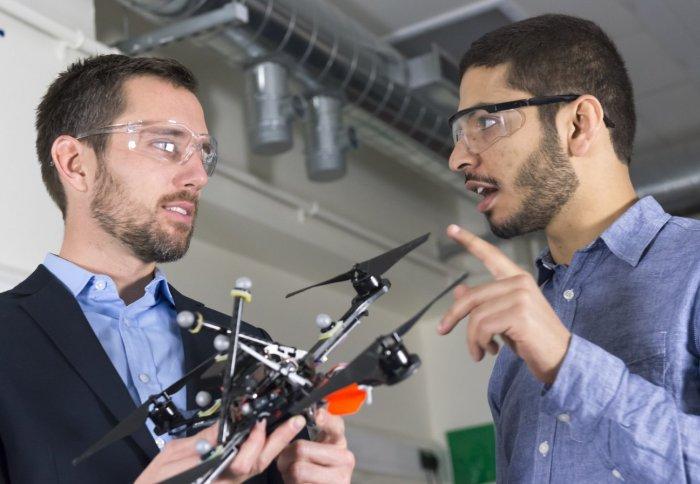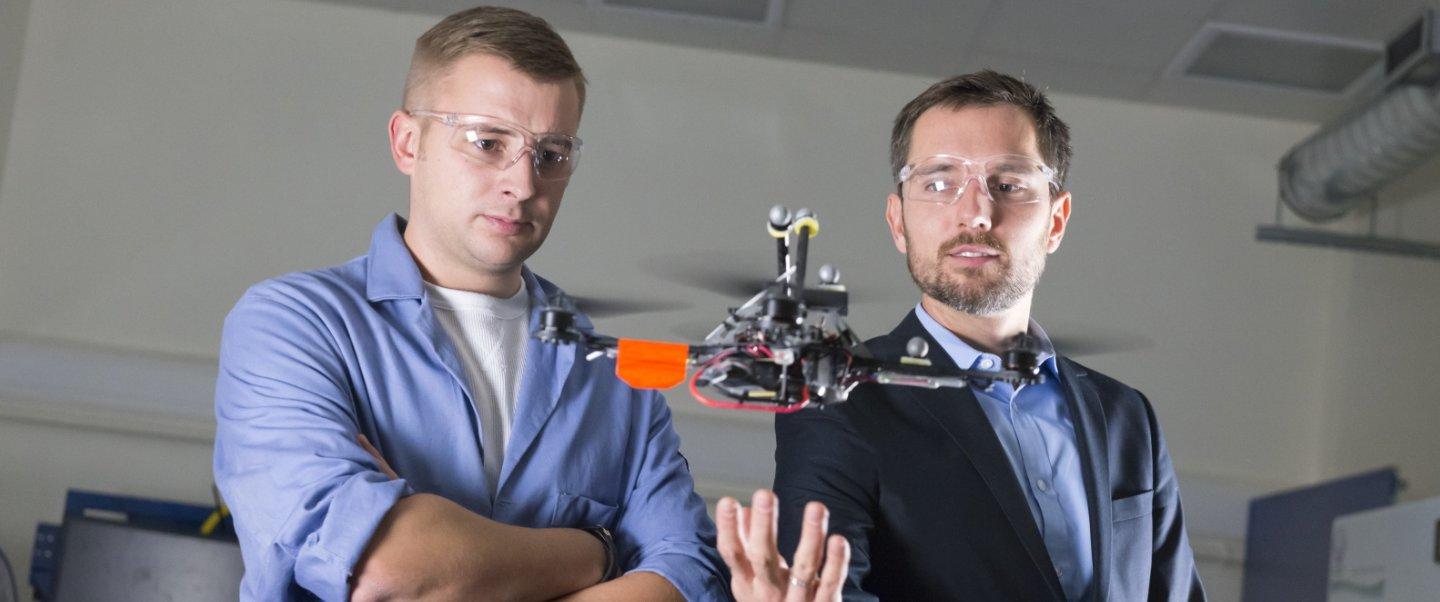Can you Imagine? Aerial Drone 3D Printers to Work as Mini Construction Factories, Also to Build Emergency Shelters
 While resentment regarding robots taking jobs and conspiracies as to how they may take over our planet and turn us into haggard, shackled captives is a continual theme–especially in very entertaining but frightening sci-fi movies—many of us actually find the prospect of having machines do our dirty work quite inviting. And one of the greatest things about robots is that they don’t complain.
While resentment regarding robots taking jobs and conspiracies as to how they may take over our planet and turn us into haggard, shackled captives is a continual theme–especially in very entertaining but frightening sci-fi movies—many of us actually find the prospect of having machines do our dirty work quite inviting. And one of the greatest things about robots is that they don’t complain.
Perfect for doing repetitive and difficult tasks without tiring, robots are definitely the wave of the future for handling a wide range of exercises that humans really don’t want to do—as well as some we’ve never thought of. It’s not all about vacuuming and sweeping our floors or putting together intricate components in factories—in fact, if Dr. Mirko Kovac has his way, they may soon be responsible for some quite noble tasks.
 We’ve followed an evolution of ideas in aerial drones emanating from this brilliant scientist already, like the flying 3D printer drone capable of being useful in the future in dangerous and harsh environments, due to an extruded glue that would allow it to pick up objects and carry them away. Shortly after that, he came up with another design leaving everyone incredulous with the concept for the MUPPette, a multi-year project meant to produce a 3D printer that will produce objects on a limitless scale.
We’ve followed an evolution of ideas in aerial drones emanating from this brilliant scientist already, like the flying 3D printer drone capable of being useful in the future in dangerous and harsh environments, due to an extruded glue that would allow it to pick up objects and carry them away. Shortly after that, he came up with another design leaving everyone incredulous with the concept for the MUPPette, a multi-year project meant to produce a 3D printer that will produce objects on a limitless scale.
Undeniably embroiled in the full-fledged research of drones and all the benefits they may be able to offer us, especially his own designs, Kovac works in the Department of Aeronautics at Imperial College London. While his is not the only work being centered around what drones, robots, and 3D printers can do for construction, it is definitely the only research focusing on doing so from the air. Continuing along with his aforementioned projects, Kovac is now saying specifically that he sees his drones as being able to perform imperative work in major construction, as well as disaster zones in the future.
Drones could be instrumental in allowing for such jobs as going into very hard to get to areas and building temporary shelter areas until emergency personnel can actually reach those in need. The shelters would probably be dome-shaped or self-constructing structures.
“Drones would fly to the [emergency] site and just observe what is happening. Once the site has been identified, and where shelters would be needed, then we could create the virtual model on the computer offsite, in a safe zone away from the site,” explains Kovac.
Kovac foresees swarms of drones being able to help in future emergency situations–working much faster and much more affordably. This concept can also be used in many other areas besides crisis situations, and definitely for improving the world of construction overall–as well as helping to construct what Kovac foresees as being ‘smart cities.’ He also foresees drones as creating more jobs rather than taking them as they will have to be manufactured, operated, and maintained–and will work at our bidding, offering greater safety and streamlining in operations.
 Kovac and his team have recently received over £3.4 million (translated to what would be nearly $5 million USD) in funding from the Engineering and Physical Sciences Research Council and industrial partners. They will continue working in the same vein obviously, but it sounds as if Kovac’s ideas are continuing to evolve, considering so many greater options available from the air. Bots are one thing, but the aerial quotient is what makes his designs inimitable so far—and coupled with additive building manufacturing (ABM), the potential is obviously enormous, globally. This is already being seen from the ground as the construction industry is delving into work with different 3D printer options and large robots which can extrude the materials to feasibly construct entire buildings.
Kovac and his team have recently received over £3.4 million (translated to what would be nearly $5 million USD) in funding from the Engineering and Physical Sciences Research Council and industrial partners. They will continue working in the same vein obviously, but it sounds as if Kovac’s ideas are continuing to evolve, considering so many greater options available from the air. Bots are one thing, but the aerial quotient is what makes his designs inimitable so far—and coupled with additive building manufacturing (ABM), the potential is obviously enormous, globally. This is already being seen from the ground as the construction industry is delving into work with different 3D printer options and large robots which can extrude the materials to feasibly construct entire buildings.
The construction industry is often mentioned as one of the sectors that will benefit the most from 3D printing, but that has not really come to fruition. Yet. With 3D printing, the benefits are vast in concept, but it is a matter of creating equipment and processes that will actually do the job. Once that all comes together, many things may change as we know it from the construction angle, with transportation and environmental impacts being greatly reduced, along with speed in manufacturing, new innovations in design, and affordability all playing a huge role.
 Kovac and his team see their aerial drones as being able to offer much greater safety in the area of construction as well, and for obvious reasons, we all know that would be welcomed by everyone. Using ABM processes in tandem with aerial drones would mean the construction of high-rises and other constructions with what are essentially mini-factories that can operate from the air.
Kovac and his team see their aerial drones as being able to offer much greater safety in the area of construction as well, and for obvious reasons, we all know that would be welcomed by everyone. Using ABM processes in tandem with aerial drones would mean the construction of high-rises and other constructions with what are essentially mini-factories that can operate from the air.
While it all sounds extremely futuristic, Kovac and his team are certainly working to make these concepts into a reality that can transform emergency management and help those in need, save lives in construction, and streamline work that currently is fraught with complexities and challenge.
“Dr. Kovac is leading the project as Principal Investigator with partners from the Dyson Robotics Lab at Imperial, the University of Bath, University College London and the Architectural Association School of Architecture. Industrial partners on the projects are leaders in construction, robotics and 3D printing including the BRE Trust, Buro Happold, Cementation Skanska, Dyson Limited and Ultimaker BV,” notes Imperial College London.
Discuss these evolving concepts in the 3D Printing Aerial Drones forum over at 3DPB.com.
[Source & Images: Imperial College London]Subscribe to Our Email Newsletter
Stay up-to-date on all the latest news from the 3D printing industry and receive information and offers from third party vendors.
You May Also Like
Precision at the Microscale: UK Researchers Advance Medical Devices with BMF’s 3D Printing Tech
University of Nottingham researchers are using Boston Micro Fabrication‘s (BMF) 3D printing technology to develop medical devices that improve compatibility with human tissue. Funded by a UK grant, this project...
3D Printing Webinar and Event Roundup: April 21, 2024
It’s another busy week of webinars and events, starting with Hannover Messe in Germany and continuing with Metalcasting Congress, Chinaplas, TechBlick’s Innovation Festival, and more. Stratasys continues its advanced training...
3D Printing Webinar and Event Roundup: March 17, 2024
It’s another busy week of webinars and events, including SALMED 2024 and AM Forum in Berlin. Stratasys continues its in-person training and is offering two webinars, ASTM is holding a...
3D Printed Micro Antenna is 15% Smaller and 6X Lighter
Horizon Microtechnologies has achieved success in creating a high-frequency D-Band horn antenna through micro 3D printing. However, this achievement did not rely solely on 3D printing; it involved a combination...





























